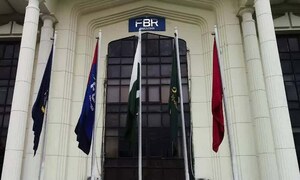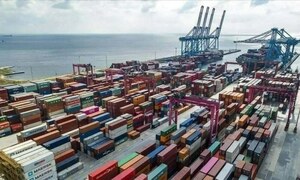Pakistani rupee traded at 127.75 per dollar in Monday's inter-bank rate to close at 121.5 per dollar - a correction reflecting a fluctuation of negative 4.89 percent during one day. This wide inter-bank rate fluctuation in the course of a single working day may well reflect State Bank of Pakistan (SBP) intervention by the close of the day due no doubt to serious concerns that the unchecked fall in rupee value would have serious negative repercussions on the heavily indebted economy as well as fuel inflation. Each one rupee fall in the rupee value vis-a-vis the dollar adds from between 85 to 100 billion rupees to the country's debt.
Moody's in its report dated January 2018, in the aftermath of around 5 percent December 2017 depreciation allowed by the Abbasi-led administration, stated that "if the Pak rupee depreciates markedly further, the country's central bank will face the difficult challenge of anchoring inflation expectations at moderate levels," and added ominously that the "government's debt affordability would likely weaken further, as the federal government's one-third debt is denominated in foreign currency."
The PML-N administration depreciated the rupee by another 5 percent in March 2018 and that too was insufficient to stem the rising current account deficit. Capital Stake Director Research Maha Jafer Butt was quoted as stating at the time that "the previous devaluation of around 5 per cent did not bring significant impacts on the stock market whereby only $19 million (December 12, 2017 to March 19, 2018) were injected in the stock market by foreign participants as compared to around $460 million outflows from the Pakistan Market since January 2017."
In March this year the first post-program monitoring report by the International Monetary Fund was uploaded on its website which stated that "Staff advised to unwind the increased government borrowing from the SBP, which would support monetary tightening. Going forward, greater exchange rate flexibility will need to be accompanied by a further adjustment of the policy stance as well as strengthening of the interest rate-based monetary policy framework with appropriate intermediate and operational monetary policy targets, and a clear limit to FX interventions."
And on 12 June 2018 Caretaker Finance Minister Dr Shamshad Akhtar stated during a press conference on 12 June 2018 that the previous administration's policy of keeping the rupee over valued was not sustainable because "if you want to stabilize the exchange rate in the long term this can be done by the foreign exchange reserves injection in the inter-bank market rate which is not sustainable. Let the exchange rate be determined by market forces." The exchange rate reserves, that had been strengthened by the Dar-led finance ministry through borrowing, directly or through debt equity through issuance of Eurobonds/Sukuk, have been consistently declining since, with the reserves touching 9.47 billion dollars on 6 July 2018 - less than three months of imports.
The stock market responded positively to Monday's rupee depreciation but ended in considerable selling by the end of the day when the inter-bank rate strengthened. One would assume that the initial positive trend was later tempered by uncertainty in the market sourced to political and recent security issues as well as market perception that the rupee would further depreciate if market forces are allowed to prevail, and this perception is unlikely to make imports unattractive or under-invoicing unattractive for exporters.
Be that as it may, we support measures that allow the rupee to reach its market value, though given the country's heavy exposure to dollar debt there is clearly a need to closely monitor the depreciation to ensure that its impact on domestic inflation and indebtedness (in rupee terms thereby raising the country's budget deficit) remains within reasonable levels. Additionally, we have repeatedly emphasized the need for the State Bank of Pakistan to impose 100 percent cash margins restriction on all imports other than essentials, industrial raw materials, medicines and in this context the decision of the SBP to impose 100 percent cash margins on 131 items is appreciated however this is not enough and the list of items needs to be further expanded.
BR100
11,839
Decreased By
-27.2 (-0.23%)
BR30
35,827
Increased By
129.6 (0.36%)
KSE100
113,563
Decreased By
-585.5 (-0.51%)
KSE30
35,742
Decreased By
-210.4 (-0.59%)

























Comments
Comments are closed.